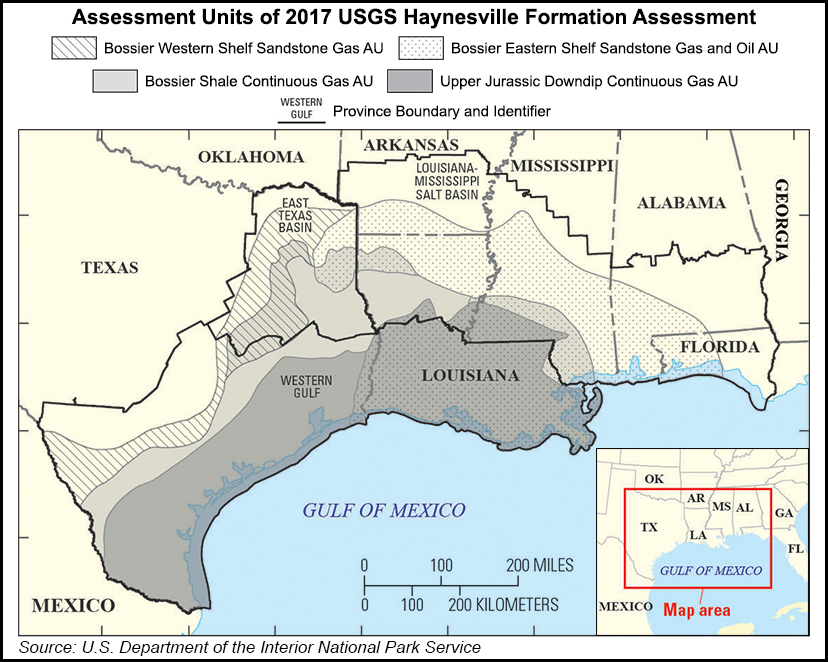E&P | Haynesville Shale | NGI All News Access | NGI The Weekly Gas Market Report
USGS: Much More Oil/Gas in Bossier, Haynesville Formations Than Previously Thought
The oil/natural gas patch has seen much technological change since 2010 — the last time the U.S. Geological Survey (USGS) assessed the resources contained in the Bossier and Haynesville formations. Technology advancements have caused resource estimates for the Gulf Coast Basin plays to balloon.

On Thursday USGS said the Bossier and Haynesville formations of the onshore and state waters portion of the U.S. Gulf Coast contain estimated means of 4.0 billion bbl of oil, 304.4 Tcf of natural gas, and 1.9 billion bbl of natural gas liquids, according to updated assessments.
Prior to this report, USGS assessed the Bossier and Haynesville in a2010 assessment of Jurassic and Cretaceous rocks of the Gulf Coast. At that time, the Bossier was estimated to contain a mean of 9.0 Tcf of natural gas, while the Haynesville was estimated to contain 61.4 Tcf.
“As the USGS revisits many of the oil and gas basins of the United States, we continually find that technological revolutions of the past few years have truly been a game-changer in the amount of resources that are now technically recoverable,” said Walter Guidroz, program coordinator of the USGS Energy Resources Program. “Changes in technology and industry practices, combined with an increased understanding of the regional geologic framework, can have a significant effect on what resources become technically recoverable.”
The new estimates, the largest continuous natural gas assessment USGS has yet conducted, include petroleum in both conventional and continuous accumulations, and consist ofundiscovered,technically recoverable resources.
The Bossier and Haynesville Formations lie within the Gulf Coast Basin, which extends from the Texas-Mexico border in the west to the Florida Panhandle in the east. The Bossier Formation is estimated to contain means of 2.9 billion bbl of oil, 108.6 Tcf of natural gas, and 1.0 billion bbl of natural gas liquids, while the Haynesville Formation is estimated to contain a mean of 1.1 billion bbl of oil, 195.8 Tcf of natural gas, and 0.9 billion bbl of natural gas liquids.
“It’s amazing what a little more knowledge can yield,” said USGS scientist Stan Paxton, lead author of the assessment. “Since the 2010 assessment, we’ve gotten updated geologic maps, expanded production history and have a greater understanding of how these reservoirs evolved. All of that leads to a better geological model and therefore a more robust assessment.”
The Bossier and Haynesville formations have long been known to contain oil and gas, but it wasn’t until 2008 that production of the continuous resources really got underway in East Texas and North Louisiana, the primary production areas for the two formations, USGS said.
“Continuous oil and gas is dispersed throughout a geologic formation rather than existing as discrete, localized occurrences, such as those in conventional accumulations. Because of that, continuous resources commonly require special technical drilling and recovery methods, such as hydraulic fracturing.”
USGS assessments are probabilistic and statistical assessments, yielding a range of possible resource amounts.
For the Bossier Formation, the assessment ranges from 37.1 Tcf of natural gas to 223.5 Tcf of natural gas, with 108.6 Tcf as the mean. For oil, the assessment ranges from 1.2 billion bbl of oil to 5.1 billion bbl of oil, with 2.9 billion bbl as the mean. For natural gas liquids, the assessment ranges from 424 million bbl to 2.0 billion bbl, with 1.0 billion bbl as the mean.
The Haynesville Formation, meanwhile, ranges from 96.3 Tcf to 341 Tcf of natural gas, with 195.8 Tcf as the mean. For oil, the assessment ranges from 286 million bbl of oil to 2.5 billion barrels of oil, with 1.1 billion bbl as the mean. For natural gas liquids, the assessment ranges from 304 million bbl to 1.7 billion bbl, with 0.9 billion bbl as the mean.
The new assessments of the Bossier and Haynesville Formations may be found online.
© 2024 Natural Gas Intelligence. All rights reserved.
ISSN © 2577-9877 | ISSN © 1532-1266 | ISSN © 2158-8023 |
